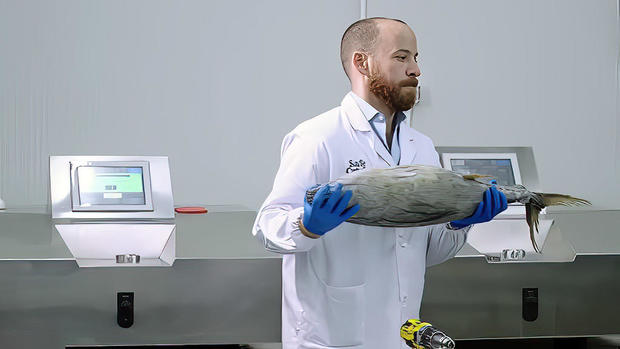Scientific Sausalito seafood seller tracks every fish from catch to can
SAUSALITO -- When you reach for your cordless electric drill, you likely won't be digging a hole in the head of a dead fish yet that is exactly what they do about ten thousand times a day at Safe Catch, a seafood distributor in Sausalito.
As for why they do this, the answer begins with Bonnie Wittenberg.
Wittenberg's design business began to suffer exactly when she did.
"I started having lots of symptoms. Like I couldn't finish my work. I'd go to do my drawing and I couldn't work out my mathematics."
Eventually, doctors discovered the culprit was mercury in the tuna-heavy diet she'd been following to lose weight.
As high on the food chain as tuna are they have a tendency to accumulate the mercury gobbled up by their smaller salty citizens.
As Woody Allen once observed, life really is just one big restaurant. And tuna are big eaters indeed -- the record weight for one particular Charlie was almost 1,000 pounds although most weigh around 130 lb.
The amount of mercury found in their flesh can vary wildly from fish to fish.
"The FDA in their studies found about one in five untested cans (of tuna) at the consumer shelf have a spike in mercury," said Bryan Boches, chief executive of Safe Catch Tuna.
If you're both unlucky and eat lots of spiky tuna you could become a storage facility for this most sickening of heavy metals.
So, why not design a machine to detect the mercury in each and every fish?
That's a question that occurred to Bonnie's husband, whose extensive background in chemistry and mechanics led him to design a device that yields rapid readings of mercury concentrations from small samples extracted from newly-deceased fish. Such a useful gizmo had not been constructed before.
None of the large tuna producers expressed interest in the mercury detector which would virtually guarantee safe levels of mercury in each can of tuna.
Enter Safe Catch and its CEO Bryan Boches.
"We individually test about 10,000 tuna a day [using Bonnie's husband's device] and we take what looks like a modified drill bit, we take a biopsy from the tuna, we put it into our machine and, in 45 seconds, we get parts per billion of mercury in the fish," Boches explained. "The reason that's so important is that two identical tuna can vary in mercury by over 10 times. We've tested over six million individual tuna. To give you an example of how big that is, all the other companies combined -- in 30 years -- don't test as many tuna as we test in a day and every individual tuna is tested, every single one. Not a batch, not a sample, but every individual one. So pregnant women, kids -- everyone -- wouldn't have to worry about eating tuna."
Nor now does Bonnie Wittenberg. Despite an arduous road to recovery, she still eats tuna and opts for the tested brand which makes a lot of sense because her son Sean is one of the founders of the company.
When he learned of his mother's mercury poisoning, he was sufficiently irate to vow to change things. To the extent that his company tests each individual tuna, he has.
"He was bound and determined to make me healthy. I mean, he's just the son everyone wants to have. I'm very proud of him," she said. "Nobody's doing every single fish. Because I had complete, utter mercury poisoning. But at least one thing's working -- this company -- and my sweetheart son is making a difference."
By the way, Bonnie's preferred recipe for a tuna sandwich is simple: sourdough slices, tuna mixed with mayonnaise and relish and lettuce.
As an aside, this correspondent would add chopped onions.
WEBLINK: Safe Catch Sausalito





